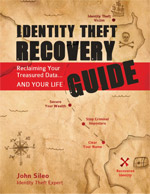5 Steps to Stop Lost Wallet Identity Theft
How to Protect Your Lost Wallet or Purse against Identity Theft
In a panic that your lost wallet or stolen purse might lead to identity theft? Take a deep breath and then take the First 5 Steps to Stop ID theft. First, you need to understand that a lost wallet or purse is one of the most concentrated sources of identifying documents. For now, assume that your lost or stolen wallet or purse will be used to exploit your identity. Sometimes, even when your missing item shows up unexpectedly, the damage has already been done by a clever thief who is simply returning your valuables so that you don’t suspect further theft and shut down your accounts. Don’t take any changes. Instead, take these first five steps (adapted from my Identity Theft Recovery Guide):
1. Inventory Your Lost Wallet or Stolen Purse from Memory

Want us to walk you through the entire recovery process with quick videos, easy forms and expert advice as you go? Click on the Recovery Guide and get started before your wealth evaporates.
The first step is to identify exactly what was in your purse or wallet. If you haven’t photocopied everything, start making a list and add to it over the next few days as you remember more. Here are some of the highest risk items:
Checks/checkbook*, Cell phone or smartphone, Keys, garage openers, Credit cards, debit cards, ATM cards, Drivers license, Student ID cards, Military ID cards, Medical ID cards, Auto insurance, Social Security card*, Loyalty cards, Bills to pay, Passport*, Library cards, Birth Certificates, Receipts, Passwords, PINs*, Child/Parent Info, Work ID…
* You should NEVER carry these items with you unless absolutely necessary for a certain occasion.
2. Make Immediate Calls & Log Conversations
The next step is to make calls regarding missing items and keep a log of all correspondence. The sooner you properly shut down these accounts, the less you will lose. (See Video or Identity Theft Recovery Guide)
3. Protect the Sensitive Data on Your Mobile Devices
If you have taken any preventive steps to protect your mobile device, such as remote tracking and wiping, don’t hesitate to remotely erase your mobile device. It is a digital treasure trove of personal identifying information. If you haven’t already implemented remote tracking and wiping on your cellphone, do so now. (Step 4)
4. Change Passwords on Affected Online Accounts
If you carried any information regarding your online accounts in your lost wallet or bag (especially on a smartphone or tablet that was stolen too), immediately change passwords on all relevant online accounts. A single mobile phone can have multiple logins for banks, investment brokers and numerous financial institutions. I highly recommend utilizing a password protection software to encrypt and protect your numerous passwords.(Step 5)
5. File a Police Report
In order to draw a line in the sand (any crimes committed in your name or money taken out of your accounts that happens after the police report are easier to defend, should it be required.) As discussed in the Guide, filing a police report can be difficult, so attempt to submit it online before trying in person. (Step 8)
In total, there are 31 unique steps for you to consider during the recovery process, including filing victim and police reports, locking criminals out of your credit, taxes and medical benefits, as well as defending your online accounts, children’s identity and safeguarding your financial investments.
John Sileo is the award-winning author of four books on identity theft, including The Identity Theft Recovery Guide. John delivers keynote speeches to conferences and companies that don’t want to end up as the next data breach headline. His clients included the Department of Defense, Pfizer, Visa and Homeland Security. Watch John keynoting, on Rachael Ray, or through the eyes of his clients.





